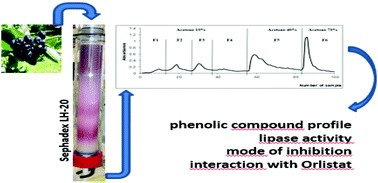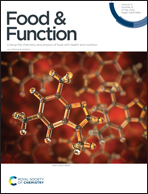Proanthocyanidins as the main pancreatic lipase inhibitors in chokeberry fruits†
Abstract
Pancreatic lipase inhibitors are recognized as important in strategies for the management of overweight and obesity. The phytocompounds in chokeberry fruit show multidirectional pro-health effects, including anti-obesity activity. The aims of this study were to fractionate and identify the phenolic compounds of chokeberry fruit phenolic-rich extract that are active as pancreatic lipase inhibitors. Phenolic compounds were fractionated using Sephadex LH-20 resin, followed by polyphenol profile analysis using chromatographic and spectrophotometric methods, while pancreatic inhibitory activity was determined using 4-methylumbelliferyl oleate and emulsified triolein as enzyme substrates. Among the six fractions isolated from extract, two fractions rich in highly polymerized proanthocyanidins showed the greatest ability to inhibit pancreatic lipase activity. In comparison, fractions containing mainly low-molecular-weight phenolic compounds, such as phenolic acids, flavonols and anthocyanins, were 11–64 times less active. The most active fraction showed a mixed mode of pancreatic lipase inhibition, as determined by Lineweaver–Burk plot analysis, and exhibited a cumulative effect with orlistat. This study shows that black chokeberry polyphenols, particularly highly polymerized procyanidins, can effectively inhibit pancreatic lipase activity determined by in vitro methods.



 Please wait while we load your content...
Please wait while we load your content...